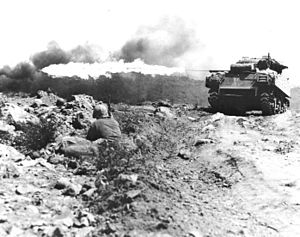
Napalm is an incendiary mixture of a gelling agent and a volatile petrochemical. The name is a portmanteau of two of the constituents of the original thickening and gelling agents: coprecipitated aluminium salts of naphthenic acid and palmitic acid. A team led by chemist Louis Fieser originally developed napalm for the US Chemical Warfare Service in 1942 in a secret laboratory at Harvard University. Of immediate first interest was its viability as an incendiary device to be used in fire bombing campaigns during World War II; its potential to be coherently projected into a solid stream that would carry for distance resulted in widespread adoption in infantry and tank/boat mounted flamethrowers as well.

A flamethrower is a ranged incendiary device designed to project a controllable jet of fire. First deployed by the Byzantine Empire in the 7th century AD, flamethrowers saw use in modern times during World War I, and more widely in World War II as a tactical weapon against fortifications.

A flame tank is a type of tank equipped with a flamethrower, most commonly used to supplement combined arms attacks against fortifications, confined spaces, or other obstacles. The type only reached significant use in the Second World War, during which the United States, Nazi Germany, Soviet Union, Italy, Japan, and the United Kingdom all produced flamethrower-equipped tanks.

The Amphibious Vehicle, Tracked (LVT) is an amphibious warfare vehicle and amphibious landing craft, introduced by the United States Navy and United States Marine Corps. The United States Army, Canadian Army and British Army used several LVT models during World War II, and referred to those vehicles as "Landing Vehicle, Tracked."
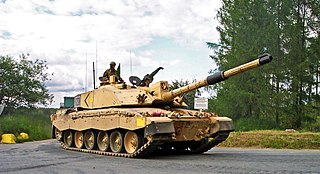
Tank classification is a taxonomy of identifying either the intended role or weight class of tanks. The classification by role was used primarily during the developmental stage of the national armoured forces, and referred to the doctrinal and force structure utility of the tanks based on design emphasis. The weight classification is used in the same way truck classification is used, and is intended to accommodate logistic requirements of the tanks.

The Universal Carrier, also known as the Bren Gun Carrier and sometimes simply the Bren Carrier from the light machine gun armament, is a common name describing a family of light armoured tracked vehicles built by Vickers-Armstrongs and other companies.

The 5th Marine Division was a United States Marine Corps ground combat division which was activated on 11 November 1943 at Camp Pendleton, California during World War II. The 5th Division saw its first combat action during the Battle of Iwo Jima in 1945 where it sustained the highest number of casualties of the three Marine divisions of the V Amphibious Corps. The 5th Division was to be part of the planned invasion of the Japan homeland before Japan surrendered. Assault troops of the 5th Division were included in the Presidential Unit Citation awarded to the V Amphibious Corps for extraordinary heroism on Iwo Jima from 19 to 28 February 1945. The 5th Division was deactivated on 5 February 1946.

The Tank, Cruiser, Ram was a cruiser tank designed and built by Canada in the Second World War, based on the U.S. M3 Medium tank chassis. Due to standardization on the American Sherman tank for frontline units, it was used exclusively for training purposes and was never used in combat as a gun tank. The chassis was used for several other combat roles however, such as a flamethrower tank, observation post and armoured personnel carrier.

The Flamethrower, Portable, No 2, also known as the Ack Pack, was a British design of flamethrower for infantry use in the Second World War.
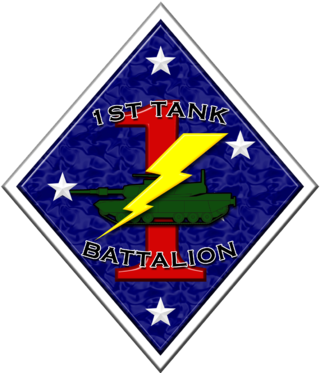
The 1st Tank Battalion was an armor battalion of the United States Marine Corps which was based out of the Marine Corps Air Ground Combat Center Twentynine Palms, California. It last fell under the command of the 1st Marine Division and I Marine Expeditionary Force. The unit was decommissioned in May 2021 as part of the service Force Design 2030 initiative which saw it move away from larger armor formations.

The Lagonda company produced a number of flamethrowers during the Second World War.
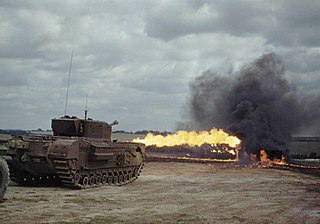
The Churchill Crocodile was a British flame-throwing tank of late Second World War. It was a variant of the Tank, Infantry, Mk IV (A22) Churchill Mark VII, although the Churchill Mark IV was initially chosen to be the base vehicle.

The Chemical Corps is the branch of the United States Army tasked with defending against and using chemical, biological, radiological, and nuclear (CBRN) weapons. The Chemical Warfare Service was established on 28 June 1918, combining activities that until then had been dispersed among five separate agencies of the United States federal government. It was made a permanent branch of the Regular Army by the National Defense Act of 1920. In 1945, it was redesignated the Chemical Corps.
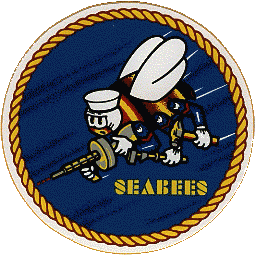
When World War II broke out the United States Naval Construction Battalions (Seabees) did not exist. The logistics of a two theater war were daunting to conceive. Rear Admiral Moreell completely understood the issues. What needed to be done was build staging bases to take the war to the enemy, across both oceans, and create the construction force to do the work. Naval Construction Battalions were first conceived at Bureau of Yards and Docks (BuDocks) in the 1930s. The onset of hostilities clarified to Radm. Moreell the need for developing advance bases to project American power. The solution: tap the vast pool of skilled labor in the U.S. Put it in uniform to build anything, anywhere under any conditions and get the Marine Corps to train it. The first volunteers came skilled. To obtain these tradesmen, military age was waived to age 50. It was later found that several past 60 had managed to get in. Men were given advanced rank/pay based upon experience making the Seabees the highest paid group in the U.S. military. The first 60 battalions had an average age of 37.

The Ordnance ML 4.2-inch mortar was a heavy mortar used by the British Army during and after World War II.

The M1 and M1A1 were portable flamethrowers developed by the United States during World War II. The M1 weighed 72 lb, had a range of 15 meters, and had a fuel tank capacity of five gallons. The improved M1A1 weighed less, at 65 lb, had a much longer range of 45 meters, had the same fuel tank capacity, and fired thickened fuel (napalm).
The Petroleum Warfare Department (PWD) was a government department established in Britain in 1940 in response to the invasion crisis during World War II, when Germany apparently would invade the country. The department was initially tasked with developing the uses of petroleum as a weapon of war, and it oversaw the introduction of a wide range of flame warfare weapons. Later in the war, the department was instrumental in the creation of the Fog Investigation and Dispersal Operation that cleared runways of fog allowing the landing of aircraft returning from bombing raids over Germany in poor visibility, and Operation Pluto, which installed prefabricated fuel pipelines between England and France soon after the Allied invasion of Normandy in June 1944.
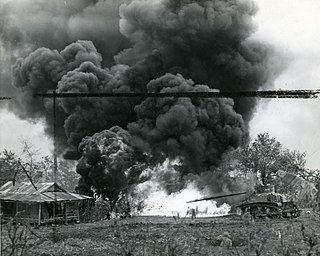
During WWII United States Naval Construction Battalions ("Seabees") modified/created all of the main armament flame throwing tanks that were used in the Pacific War: by USMC in the Battle of Saipan, Battle of Tinian, Battle of Iwo Jima, and by the U.S. Army in the Battle of Okinawa.

When WWII broke the United States had no mechanized flamethrowing capability. It is believed that an officer in the 754th U.S. Army tank battalion came up with the idea of mounting a flame thrower on a M3 Light tank on the island of New Caledonia. The Army used the idea on New Georgia and the Marines during the Battle of Bougainville. After which further development passed to the U.S. Army. Chemical Warfare Service at Schofield Barracks, Territory of Hawaii. There the Army reached out to the United States Naval Construction Force for assistance. The Seabees accepted the offer and converted or modified nearly 400 tanks for the Army. Those weapons set the standard for the U.S. through the Korean War. It was not until 1955 that a superior flame throwing tank replaced the Shermans the Seabees created.

Fuel Research Aluminium Stearate (FRAS), is mixture of chemical substances, used as an incendiary agent by the United Kingdom during the Second World War.
